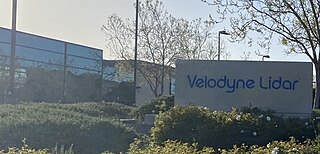Related Research Articles

A self-driving car, also known as a autonomous car (AC), driverless car, robotaxi, robotic car or robo-car, is a car that is capable of operating with reduced or no human input. Self-driving cars are responsible for all driving activities, such as perceiving the environment, monitoring important systems, and controlling the vehicle, which includes navigating from origin to destination.

Vehicular automation is the use of technology to assist or replace the operator of a vehicle such as a car, truck, aircraft, rocket, military vehicle, or boat. Assisted vehicles are semi-autonomous, whereas vehicles that can travel without a human operator are autonomous. The degree of autonomy may be subject to various constraints such as conditions. Autonomy is enabled by advanced driver-assistance systems (ADAS) of varying capacity.

Daniela L. Rus is a Romanian-American computer scientist. She serves as director of the MIT Computer Science and Artificial Intelligence Laboratory (CSAIL), and the Andrew and Erna Viterbi Professor in the Department of Electrical Engineering and Computer Science (EECS) at the Massachusetts Institute of Technology. She is the author of the books Computing the Future, The Heart and the Chip: Our Bright Future with Robots, and The Mind's Mirror: Risk and Reward in the Age of AI.

Velodyne Lidar is a Silicon Valley–based lidar technology company, headquartered in San Jose, California. It was spun off from Velodyne Acoustics in 2016. As of July 2020, the company has had about 300 customers. Velodyne Lidar ships sensors to mobility industry customers for testing and commercial use in autonomous vehicles, advanced driver assistance systems, mapping, robotics, infrastructure and smart city applications. In February 2023, the company merged with Ouster.

Waymo LLC, formerly known as the Google Self-Driving Car Project, is an American autonomous driving technology company headquartered in Mountain View, California. It is a subsidiary of Alphabet Inc.

Mobileye Global Inc. is an Israeli autonomous driving company. It is developing self-driving technologies and advanced driver-assistance systems (ADAS) including cameras, computer chips, and software. Mobileye was acquired by Intel in 2017 and went public again in 2022.

Experiments have been conducted on self-driving cars since 1939; promising trials took place in the 1950s and work has proceeded since then. The first self-sufficient and truly autonomous cars appeared in the 1980s, with Carnegie Mellon University's Navlab and ALV projects in 1984 and Mercedes-Benz and Bundeswehr University Munich's Eureka Prometheus Project in 1987. In 1988, William L Kelley patented the first modern collision Predicting and Avoidance devices for Moving Vehicles. Then, numerous major companies and research organizations have developed working autonomous vehicles including Mercedes-Benz, General Motors, Continental Automotive Systems, Autoliv Inc., Bosch, Nissan, Toyota, Audi, Volvo, Vislab from University of Parma, Oxford University and Google. In July 2013, Vislab demonstrated BRAiVE, a vehicle that moved autonomously on a mixed traffic route open to public traffic.
A robotaxi, also known as robot taxi, robo-taxi, self-driving taxi or driverless taxi, is an autonomous car operated for a ridesharing company.
Increases in the use of autonomous car technologies are causing incremental shifts in the responsibility of driving, with the primary motivation of reducing the frequency of traffic collisions. Liability for incidents involving self-driving cars is a developing area of law and policy that will determine who is liable when a car causes physical damage to persons or property. As autonomous cars shift the responsibility of driving from humans to autonomous car technology, there is a need for existing liability laws to evolve to reasonably identify the appropriate remedies for damage and injury. As higher levels of autonomy are commercially introduced, the insurance industry stands to see higher proportions of commercial and product liability lines of business, while the personal automobile insurance line of business shrinks.

Argo AI LLC was an autonomous driving technology company headquartered in Pittsburgh, Pennsylvania. The company was co-founded in 2016 by Bryan Salesky and Peter Rander, veterans of the Google and Uber automated driving programs. Argo AI was an independent company that built software, hardware, maps, and cloud-support infrastructure to power self-driving vehicles. Argo was mostly backed by Ford Motor Co. (2017) and the Volkswagen Group (2020). At its peak, the company was valued at $7 billion.

Oxa is an autonomous vehicle software company, headquartered in Oxfordshire, England, and founded by Paul Newman and Ingmar Posner.
Cruise LLC is an American self-driving car company headquartered in San Francisco, California. Founded in 2013 by Kyle Vogt and Dan Kan, Cruise tests and develops autonomous car technology. The company is a largely autonomous subsidiary of General Motors. Following a series of incidents, it suspended operations in October 2023, and Kyle Vogt resigned as CEO in November 2023. The company began returning its vehicles to public roads in May 2024.

A self-driving truck, also known as an autonomous truck or robo-truck, is an application of self-driving technology aiming to create trucks that can operate without human input. Alongside light, medium, and heavy-duty trucks, many companies are developing self-driving technology in semi trucks to automate highway driving in the delivery process.
Drive.ai, a subsidiary of Apple Inc., is an American technology company headquartered in Mountain View, California that uses artificial intelligence to make self-driving systems for cars. It has demonstrated a vehicle driving autonomously with a safety driver only in the passenger seat. To date, the company has raised approximately $77 million in funding. Drive.ai's technology can be modified to turn a vehicle autonomous.

Avride Inc. is a developer of self-driving cars and delivery robots. It is organized in Delaware and headquartered in Austin, Texas, with offices in Ann Arbor, Michigan, Tel Aviv, and Seoul. It is a subsidiary of Nebius Group and was formerly an affiliate of Yandex called Yandex SDG.

Pony.ai is a global autonomous vehicle technology company co-located in Silicon Valley, Beijing, and Guangzhou.
Internet of vehicles (IoV) is a network of vehicles equipped with sensors, software, and the technologies that mediate between these with the aim of connecting & exchanging data over the Internet according to agreed standards. IoV evolved from Vehicular Ad Hoc Networks, and is expected to ultimately evolve into an "Internet of autonomous vehicles". It is expected that IoV will be one of the enablers for an autonomous, connected, electric, and shared (ACES) Future Mobility.
The impact of self-driving cars is anticipated to be wide-ranging in many areas of daily life. Self-driving cars have been the subject of significant research on their environmental, practical, and lifestyle consequences and their impacts remain debated.
Regulation of self-driving cars, autonomous vehicles and automated driving system is an increasingly relevant topic in the automotive industry strongly related to the success of the actual technology. Multiple countries have passed local legislation and agreed on standards for the introduction of autonomous cars.
References
- ↑ "The Internet of Autonomous Things". Archived from the original on April 19, 2017.
- ↑ "The Internet-of-Autonomous-Things (IoAT)". ResearchGate.
- ↑ "IoT to IoAT: Internet of Autonomous Things devices provides solutions - Control Engineering". www.controleng.com. April 30, 2016.
- ↑ "Big Data Critical in IoT to the Progression from Connected to Autonomous Things – Cloudera VISION". October 20, 2016.
- ↑ "Top 10 Tech Trends: Autonomous Agents and Things – IT Products & Solutions". Archived from the original on April 19, 2017. Retrieved April 18, 2017.
- ↑ "Watch: How a self-piloting drone works". Newsweek . January 21, 2016.
- ↑ "Self-flying drone dips, darts and dives through trees at 30 mph – MIT CSAIL". www.csail.mit.edu.
- ↑ "Forecasts – Driverless car market watch". www.driverless-future.com.
- ↑ "IBM is working on a robot that takes care of elderly people who live alone". Business Insider .
- ↑ Mulligan, Gabriella (March 17, 2017). "Is robotics a solution to the growing needs of the elderly?". BBC News.
- ↑ "Autonomous Weapons "Could Be Developed for Use Within Years," Says Arms-Control Group". IEEE Spectrum. April 14, 2016.
- ↑ Rosenberg, Matthew; Markoff, John (October 25, 2016). "The Pentagon's 'Terminator Conundrum': Robots That Could Kill on Their Own". The New York Times.
- ↑ "Why Deep Learning Is Suddenly Changing Your Life".
- ↑ "Turing Learning breakthrough: Computers can now learn from pure observation – ExtremeTech". Extremetech. August 30, 2016.
- ↑ Kelly, Kevin. "The Three Breakthroughs That Have Finally Unleashed AI on the World". Wired.
- ↑ Vehicles, California Department of Motor. "Deployment of Autonomous Vehicles for Public Operation". www.dmv.ca.gov.
- ↑ "Worried about cybersecurity and the connected car? There's a bill for that". January 26, 2017.
- ↑ "Connected cars: security and privacy risks on wheels". iapp.org.
- ↑ "A Future Full of Drones – and the Advanced Threats They Present". April 29, 2016.
- 1 2 Steven Overly (February 20, 2017). "The big moral dilemma facing self-driving cars". The Washington Post . Retrieved April 18, 2017.
"[..] Would we accept that?" asks John Hanson, a spokesman for the Toyota Research Institute, which is developing the automaker's self-driving technology.
- ↑ Bryant Walker Smith (December 18, 2013). "Human error as a cause of vehicle crashes" . Retrieved April 18, 2017.
- ↑ "Quick Facts 2015". US DOT . Retrieved April 18, 2017.
- ↑ "Road traffic deaths". World Health Organization.
- ↑ "Death Rate per Year". Bureau of Aircraft Accidents Archives (ACRO). Retrieved April 18, 2017